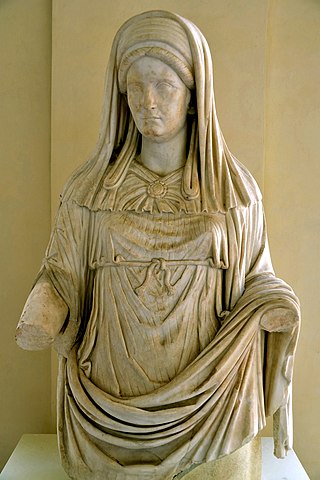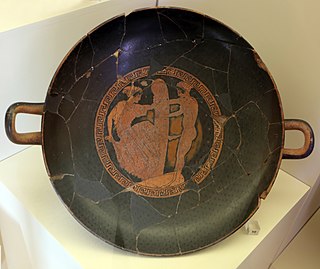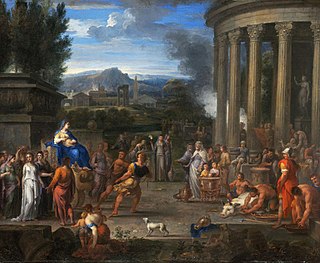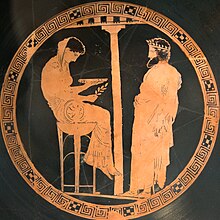
In ancient Greek religion and mythology, Artemis is the goddess of the hunt, the wilderness, wild animals, nature, vegetation, childbirth, care of children, and chastity. In later times, in some places, she was identified with Selene, the personification of the Moon. She often roamed the forests of Greece, attended by her large entourage, mostly made up of nymphs, some mortals, and hunters. The goddess Diana is her Roman equivalent.

The Parthenon is a former temple on the Athenian Acropolis, Greece, that was dedicated to the goddess Athena during the fifth century BC. Its decorative sculptures are considered some of the high points of classical Greek art, an enduring symbol of Ancient Greece, democracy and Western civilization.

A priest is a religious leader authorized to perform the sacred rituals of a religion, especially as a mediatory agent between humans and one or more deities. They also have the authority or power to administer religious rites; in particular, rites of sacrifice to, and propitiation of, a deity or deities. Their office or position is the 'priesthood', a term which also may apply to such persons collectively. A priest may have the duty to hear confessions periodically, give marriage counseling, provide prenuptial counseling, give spiritual direction, teach catechism, or visit those confined indoors, such as the sick in hospitals and nursing homes.

Pythia was the name of the high priestess of the Temple of Apollo at Delphi. She specifically served as its oracle and was known as the Oracle of Delphi. Her title was also historically glossed in English as the Pythoness.

Mut, also known as Maut and Mout, was a mother goddess worshipped in ancient Egypt. Her name means mother in the ancient Egyptian language. Mut had many different aspects and attributes that changed and evolved greatly over the thousands of years of ancient Egyptian culture.

In ancient Rome, the Vestal Virgins or Vestals were priestesses of Vesta, virgin goddess of Rome's sacred hearth and its flame.

Religious practices in ancient Greece encompassed a collection of beliefs, rituals, and mythology, in the form of both popular public religion and cult practices. The application of the modern concept of "religion" to ancient cultures has been questioned as anachronistic. The ancient Greeks did not have a word for 'religion' in the modern sense. Likewise, no Greek writer known to us classifies either the gods or the cult practices into separate 'religions'. Instead, for example, Herodotus speaks of the Hellenes as having "common shrines of the gods and sacrifices, and the same kinds of customs."

Arrhephoria was a feast among the Athenians, instituted in honor of Athena. The word is derived from the Greek term Ἀρρηφόρια, which is composed of ἄρρητος, "unspoken, not to be divulged", and φέρω, "I carry". This feast was also called Hersiphoria, from Herse, the daughter of Cecrops, on whose account it was established.
An Arrephoros was a girl acolyte in the cult of Athena Polias on the Athenian Acropolis. They were seven to eleven years old. According to Pausanias, two Arrephoroi lived for a year on the Acropolis and concluded their term with a mystery rite called the Arrhephoria: they carried unknown objects into a cavern, and there exchanged them for other unknown objects.

Haloa or Alo (Ἁλῶα) was an Attic festival, celebrated principally at Eleusis, in honour of Demeter, protector of the fruits of the earth, of Dionysus, god of the grape and of wine, and Poseidon, god of the seashore vegetation. In Greek, the word hálōs (ἅλως) from which Haloa derives means “threshing-floor” or “garden.” While the general consensus is that it was a festival related to threshing—the process of loosening the edible part of cereal grain after harvest—some scholars disagree and argue that it was instead a gardening festival. Haloa focuses mainly on the “first fruits” of the harvest, partly as a grateful acknowledgement for the benefits the husbandmen received, partly as prayer that the next harvest would be plentiful. The festival was also called Thalysia or Syncomesteria.
The Chalkeia festival, the festival of Bronze-workers, was a religious festival devoted to the goddess Athena and the god Hephaestus. It was celebrated on the last day of Pyanepsion. The festival celebrated Athena and Hephaestus, in honor of both gods as patron deities of Athens, and as deities of handicrafts.

Joan Breton Connelly is an American classical archaeologist and Professor of Classics and Art History at New York University. She is Director of the Yeronisos Island Excavations and Field School in Cyprus. Connelly was awarded a MacArthur Fellowship in 1996. She received the Archaeological Institute of America Excellence in Undergraduate Teaching Award in 2007 and held the Lillian Vernon Chair for Teaching Excellence at New York University from 2002 to 2004. She is an Honorary Citizen of the Municipality of Peyia, Republic of Cyprus.
Worshipers of Artemis were found all over the ancient Greek world. One of the most famous worshiping sites for Artemis was in Attica at Brauron. Artemis is said to have presided over all the biological transitions of females from before puberty to the first childbirth. "Young girls began to prepare for the event of the first childbirth at an early age. Even before menarche young girls danced for Artemis, in some places playing the role of animals. At the Attic site, or Brauron, in the rite called arkteia, girls representing the polis of Athens imitated she-bears, arktoi." "The initiation ritual for girls was called the Brauronia, after the location of Artemis' shrine at Brauron, in Attica, where the ritual, performed by girls before they reached puberty, took place." Brauron is the site where Iphigenia, Agamemnon’s daughter, is said to have established a temple to Artemis by decree of Athena, as told in Euripides’ Iphigenia in Tauris.
Bouzyges is a culture hero from Greek mythology, credited with the invention of many agricultural practices; most notably, he was the first man to yoke oxen to a plough and introduced cultivation to Athens. He has been associated with Epimenides.

Eritha was a Mycenaean Greek priestess. She was one of the most significant priestesses in the Mycenaean state of Pylos, in southwestern Peloponnese. Eritha was in charge of a sanctuary dedicated to the goddess Potnia. She was also involved in a dispute with the local authorities over the taxable assets of the sanctuary.

The High Priestess of Athena Polias held the highest religious office in Ancient Athens.

The Priestess of Hera at Argos was the High Priestess of the Goddess Hera, the protective city deity of Ancient Argos, on the Heraion of Argos in Argos.
Priestess of Hathor or Prophetess of Hathor was the title of the Priestess of the goddess Hathor in the Temple of Dendera in Ancient Egypt.
Hymnia was an epithet of the Greek goddess Artemis under which she was worshipped throughout Arcadia. She had a temple someplace between Orchomenus and Mantineia. We know from the geographer Pausanias that Orchomenus at least used to hold festivals in her honor.

The Priestess of Demeter and Kore, sometimes referred to as the High Priestess of Demeter, was the High Priestess of the Goddesses Demeter and Persephone (Kore) in the Telesterion in Eleusis in Ancient Athens. It was one of the highest religious offices in Ancient Athens, and its holder enjoyed great prestige. It was likely the oldest priesthood in Athens, and also the most lucrative priesthood in all of Attica.
















